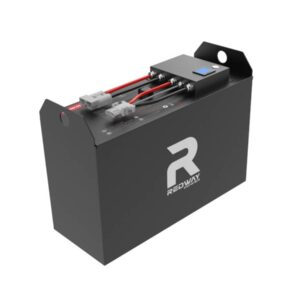How to prolong battery lifespan?
Prolonging battery lifespan requires avoiding extreme temperatures (0–45°C ideal), partial discharges (20–80% SOC), and using manufacturer-recommended chargers. Lithium-ion/LiFePO4 batteries benefit from shallow cycles, firmware-updated BMS, and storage at 50% charge in cool environments. Regular cell balancing and avoiding 100% DOD extend cycle counts by 2–3x. Pro Tip: Never leave batteries fully charged/discharged for extended periods—store at 3.8V/cell for longevity.
How to Maximize Forklift Battery Lifespan
How does charging strategy affect battery lifespan?
Optimal charging prevents voltage stress and lithium plating. Avoid 0–100% cycles—partial charges (e.g., 30–70%) reduce electrode degradation. Use smart chargers with CC-CV protocols and temperature compensation to prevent overvoltage.

Charging to 4.2V/cell (full charge) accelerates cathode oxidation, while keeping cells below 4.1V (≈90% SOC) halves degradation rates. For instance, EVs programmed to charge to 80% gain 60% more cycles than fully charged packs. Pro Tip: If full charges are unavoidable (e.g., long trips), discharge to 50% immediately afterward. Lithium plating—a key failure mode—occurs below 0°C; always pre-warm batteries in freezing conditions. Transitional phases in electrode materials stabilize better with moderate SOC swings. But what if you need maximum capacity? Prioritize partial charges 90% of the time, reserving full cycles for emergencies.
| Charging Method | Cycle Life | Capacity Retention |
|---|---|---|
| 100% DOD | 500 cycles | 60% at 2 years |
| 50% DOD | 1,500 cycles | 85% at 4 years |
Why is temperature management critical?
Heat accelerates chemical degradation—every 10°C above 25°C doubles aging rates. Cold charging (<5°C) causes metallic lithium deposition, permanently reducing capacity. Active cooling systems maintain 15–35°C for optimal performance.
Batteries in solar storage setups often face 50°C+ ambient temps, which can slash lifespan by 70% without liquid cooling. A well-designed thermal system uses phase-change materials or chilled coolant loops. For example, Tesla’s battery packs maintain ±2°C cell variation via glycol cooling. Pro Tip: Never charge a battery that’s hot from discharge—wait until it cools below 40°C. Transitional strategies like parking EVs in shade after DC fast charging mitigate heat soak. But how do you handle sub-zero conditions? Preheat cells to 15°C using built-in resistive heaters or external blankets.
| Temperature | Capacity Loss/Year | Cycle Life |
|---|---|---|
| 25°C | 4% | 1,200 |
| 40°C | 35% | 400 |
How does depth of discharge (DOD) impact longevity?
Shallow discharges (20–30% DOD) minimize lattice strain in electrodes. LiFePO4 cells cycled at 20% DOD achieve 8,000+ cycles vs. 2,000 cycles at 80% DOD. Keep average DOD below 50% for consumer electronics.
Think of DOD like bending a paperclip—repeated deep bends (full cycles) cause metal fatigue faster. A golf cart battery cycled daily to 50% DOD lasts 6 years, while one drained to 5% SOC survives just 18 months. Pro Tip: Program inverters/controllers to cut off at 20% SOC—most BMS units only prevent 0% damage. Transitional discharge curves matter too: rapid high-current draws from low SOC increase voltage sag and internal resistance. But what about occasional deep discharges? They’re acceptable (<5% of cycles) if followed by immediate partial recharge to 50%.
What storage practices preserve unused batteries?
Store lithium batteries at 40–60% SOC and 10–15°C. Full charge storage causes electrolyte oxidation, while empty cells risk copper dissolution. Check voltage every 6 months, topping up to 50% if below 30%.
Industrial drone batteries left at 100% charge for 3 months lose 20% capacity irreversibly. Conversely, storing at 3.7–3.8V/cell (≈50% SOC) in a refrigerator (not freezer) limits aging to 2% annually. Pro Tip: Use moisture-proof bags for cold storage to prevent condensation. Transitional measures include disconnecting batteries from devices—parasitic drains (even 5mA) can fully deplete cells in weeks. For multi-year storage, lithium polymer cells fare better than cylindrical ones due to lower self-discharge (1–2%/month vs. 3–5%).
Forklift Battery Maintenance Checklist Essentials
How does a BMS enhance battery lifespan?
Battery Management Systems (BMS) prevent overcharge, over-discharge, and balance cell voltages. Advanced BMS units track State of Health (SOH), throttle charging during temperature spikes, and enable firmware updates for aging algorithms.
A 12S LiFePO4 pack with ±20mV cell imbalance loses 15% capacity after 200 cycles, while a balanced pack retains 95%. Modern BMS solutions use active balancing (transfusing energy between cells) instead of passive resistor-based methods. For example, Orion BMS modules extend EV battery life by dynamically adjusting charge rates per cell group. Pro Tip: Always opt for BMS with cell-level temperature monitoring—single-point sensors miss hot spots. Transitional BMS features like predictive analytics can warn users about impending cell failures weeks in advance.
Battery Expert Insight
FAQs
What’s the ideal storage charge level for lithium batteries?
40–60% SOC (3.7–3.8V/cell). Storing fully charged batteries accelerates electrolyte breakdown, while empty cells risk undervoltage damage.
Does fast charging degrade batteries faster?
Yes—1C charging causes 15% more capacity loss/year vs 0.5C. Use fast charging sparingly, and never above 45°C cell temperature.
